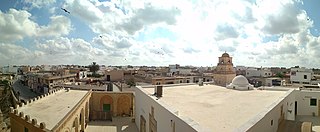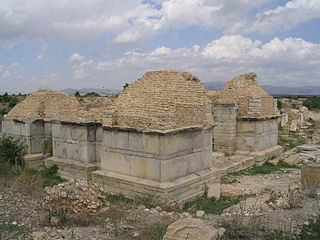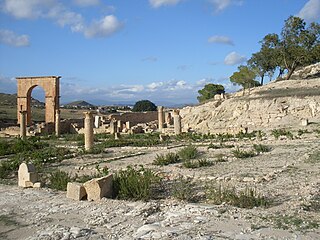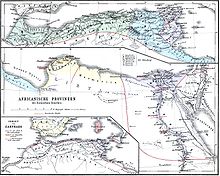
Thysdrus was a Carthaginian town and Roman colony near present-day El Djem, Tunisia. Under the Romans, it was the center of olive oil production in the provinces of Africa and Byzacena and was quite prosperous. The surviving amphitheater is a World Heritage Site.

Sousse or Soussa is a city in Tunisia, capital of the Sousse Governorate. Located 140 km (87 mi) south of the capital Tunis, the city has 271,428 inhabitants (2014). Sousse is in the central-east of the country, on the Gulf of Hammamet, which is a part of the Mediterranean Sea. Its economy is based on transport equipment, processed food, olive oil, textiles, and tourism. It is home to the Université de Sousse.

Hadrumetum, also known by many variant spellings and names, was a Phoenician colony that pre-dated Carthage. It subsequently became one of the most important cities in Roman Africa before Vandal and Umayyad conquerors left it ruined. In the early modern period, it was the village of Hammeim, now part of Sousse, Tunisia.

Byzacena was a Late Roman province in the central part of Roman North Africa, which is now roughly Tunisia, split off from Africa Proconsularis.

El Djem or El Jem is a town in Mahdia Governorate, Tunisia. Its population was 21,576 at the 2014 census. It is home to Roman remains, including the Amphitheatre of El Jem.

The Catholic Church in Tunisia is part of the worldwide Catholic Church, under the spiritual leadership of the Pope in Rome.

Haïdra is a municipality in western Tunisia, containing the ruins of Ammaedara, one of the oldest Roman cities in Africa. It was a diocese and is now a Roman Catholic titular see.

Segermes is an ancient town in Tunisia. Under the Roman Empire, the town belonged to the province of Byzacena. The town is identified with ruins at Henchir Harat, Zaghouan.
Hirina (Hirena) was a city and bishopric in southern Tunisia known only through ecclesiastical records.

Kasserine is the capital city of the Kasserine Governorate, in west-central Tunisia. It is situated below Jebel ech Chambi, Tunisia's highest mountain. Its population is 114,463 (2020).

Bir El Hafey is a town and commune located at 34°55′48″N 9°12′00″E in the Sidi Bouzid Governorate, in Tunisia. As of 2004 it had a population of 6,405.

Kalâa Kebira is a town and commune in the Sousse Governorate, Tunisia. As of 2004 it had a population of 45,990.

Quaestoriana was an ancient civitas (town) and bishopric in Roman Byzacena(North Africa). Quaestoriana is also a suppressed and titular see of the province of Byzacena in the Roman Catholic Church. The current bishop is Manuel Antonio Valarezo Luzuriaga. Its present location is in modern Tunisia.
Aquae Albae in Byzacena was an Ancient city and bishopric in Roman Africa and remains a Latin Catholic titular see.

Decoriana was an ancient Roman–Berber city and former bishopric in Tunisia. It is now a Latin Catholic titular see.

Dhorbania, also known as Henchir Oued Nebhana, is a village and locality in Tunisia. It's also the site of Ancient city and former bishopric Bahanna, now a Latin Catholic titular see.

Vita was a Roman–Berber civitas in Africa Proconsularis. It is a former Christian diocese and Latin Catholic titular see.

Tamalluma is a former Roman city which remains a Latin Catholic titular bishopric

Pheradi Majius is a locality and archaeological site in Tunisia located at 36.250003°N 10.397047°E near the modern town of Sidi Khalifa in Sousse Governorate, Tunisia that is located at 36° 14′ 58″ N, 10° 23′ 57″E.

Gummi in Byzacena was a city and bishopric in Roman Africa, which remains a Latin Catholic titular see.















